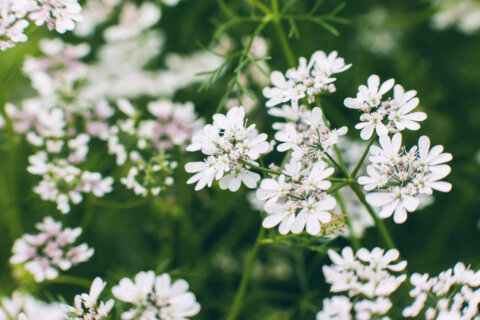
At night ground beetles eat pests such as slugs, cutworms and grubs.
We often talk about attracting bees and other pollinators to the garden. But pollinators are only one kind of beneficial insect. There are also predators, parasites and decomposers. All are important in a healthy yard and garden.
In the Pacific Northwest there are more than 28,000 species of insects, but only one to two percent damage crops, plants or structures, according to the OSU Extension Service. Most are beneficial and help gardeners with controlling garden pests or pollinating fruits and vegetables.
Types of beneficial insects
- Pollinators include bees, flies, butterflies and moths. They transfer pollen from flower to flower, which is essential to seed and food production for plants.
- Predators include lady beetles, praying mantis, lacewings, ground beetles, minute pirate bugs, damsel bugs, syrphid fly larvae and snake flies. They eat a large number of other insects and keep down the level of pests.
- Parasites (or parasitoids) are small insects that live on or in a host insect. They feed on the host and usually kill it over time. Common beneficial parasites are small stingless wasps and tachinid flies. Many are very small and you usually can’t see them, but research shows they have an important impact on pest insect populations.
- Decomposers feed on dead or decaying organic matter and help break down plant tissue, releasing nutrients and creating organic material that enriches the soil.
How to encourage beneficial insects
Create habitats
- Provide ground covers and coarse mulches such as straw, bark dust and organic leaf mulch. This provides ground beetles and rove beetles a place to hide from their enemies during the day. At night these beetles eat slugs, cutworms and grubs.
- Leave a patch of bare soil or a bed of sparsely planted ornamental grass clumps. This provides habitat for native bees.
- Plant trees and shrubs to provide shelter and a place for beneficial insects to overwinter.
- Don’t till frequently. This can destroy native bee nests.
- Have some lawn area. Some beneficial insects, such ladybird beetles (ladybugs), ground beetles and spiders, occur in lawns.
- Leave some dead plant material. For example, hollow stems provide habitat for native bees.
Provide food and water
Insects need water to live. A simple way to provide water is a saucer filled with pebbles. Keep it full on dry days. A bird bath is another option. Or you could install a water feature, which also adds beauty to your garden. If you include a fountain or waterfall in your water feature, it will keep the water moving so mosquitoes can’t breed.

Umbels, or plants with umbrella-shaped clusters (umbels) of tiny flowers, attractive beneficial insects such as pollinators and parasites.
Insects need food. Variety is important.
- For adult pollinators: Try to provide at least three species of blooming plants at any given time, spring through fall, to provide nectar for bees and other pollinators. “Recent research shows that areas that include 15 or more species of flowering plants increase bee diversity,” said the OSU Extension Service.
- For larvae of butterflies and moths: The leaves of native, ornamental trees and shrubs provide food for larvae as well as places where adult butterflies and moths can lay their eggs.
- For parasites: Provide plants that have umbrella-shaped clusters (umbels) of tiny flowers such as carrots, cilantro, dll, sweet clover and Queen Anne’s lace. These plants are also attractive to pollinators.
Practice integrated pest management
IPM is a comprehensive and systematic approach to plant problems. “It focuses on long-term prevention of pests or their damaging by managing the ecosystem,” said the University of California IPM Program. IPM is a process you can use to solve pest problems while minimizing the risks to people, pets and the environment.
IPM steps
Step 1. Identify the pest. If you are seeing damage to a plant, find out what is causing the damage. If there are insects visible, are they beneficial, such as predators, or problem insects?
Step 2. Monitor pest activity. Pay attention to your garden. If you find pests, are there few enough that you can tolerate the damage? Sometimes pest populations decline due to natural forces.
Step 3. Decide when you need to take action. Many plant problems, when detected early, can be managed through non-chemical means. When do you decide that “enough is enough”?
Step 4. Explore options to manage the problem and use a combination of tools.
- Begin with prevention. “Crops are less likely to get pests in the first place if they are pest-resistant varieties and are grown under conditions that optimize fertility and plant health,” said the Northwest Center for Alternatives to Pesticides. For example, is the plant getting enough sunlight or water? Or too much?
- Consider physical and mechanical options, such as spraying water to dislodge pests or using a barrier to keep slugs and snails away from plants.
- Consider biological options. Beneficial insects play an important role in managing pests and their damage.
- If populations are high or damage is severe, consider using pesticides. Be aware that beneficial insects are very sensitive to insecticides. If you must use a pesticide, choose the least-toxic option. “The key is to choose products that have little or no residual activity,” said Penn State Extension. “While the beneficials present when you spray will be killed, new ones coming into your garden will not be affected.”
- Spray limited amounts and make spot treatments rather than broad-scale applications. Make sure you are spraying the right part of the plant at the right time for it to have an impact. Spray in the cooler parts of the day, such as dusk or evening, when most pollinators are less active.
Step 5. Evaluate results. Find out how well your pest management worked.
